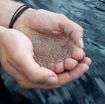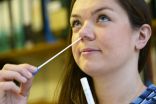(Press-News.org) SAN FRANCISCO, Nov. 19, 2014 -- Hox genes are master body-building genes that specify where an animal's head, tail and everything in between should go. There's even a special Hox gene program that directs the development of limbs and fins, including specific modifications such as the thumb in mice and humans. Now, San Francisco State University researchers show that this fin- and limb-building genetic program is also utilized during the development of other vertebrate features.
The discovery means this ancient genetic program is employed in a variety of features beyond fins and limbs. For instance, this Hox program helps to pattern the barbels in paddlefish -- sensory organs near the fish's mouth. In addition, the limb-building program had previously been observed in a cluster of genes called the HoxD genes. But SF State Associate Professor of Biology Karen Crow and her colleagues demonstrated for the first time that the program also operates in the HoxA cluster of genes during the development of the vent, a structure in all ray-finned fishes that is similar to a urethra, indicating that the regulation of this expression pattern is older and more widely utilized than thought.
Together, these new findings "really expand our view of this Hox limb-building program," said Crow. "Now we think it could be associated with all kinds of features that arise in different species."
"There is tremendous interest in animal diversity and how novel features arise in evolution," she added, "and we're just beginning to understand the genetic basis of morphological diversity."
Hox genes are the master regulatory genes that specify the identity and position of body parts during an animal's development. Hox genes are expressed at different times and places in the developing embryo, and that pattern of expression "acts like a code that sets up an address system for body parts," Crow explained.
One kind of Hox expression pattern establishes the "address" for the head-to-tail locations of body parts. But a reversal of this pattern, for some Hox genes, creates a code that specifies body parts that extend out away from the body, like fins, limbs, or now even barbels or vents. Evolutionary biologists have been intensely interested in this limb-building program, because it is part of the genetic basis of how fins evolved to become limbs, and how specialized structures arose in human evolution, such as the genetic code that specifies the thumb should be different from the other digits.
Researchers know that this limb-building program has operated at least since the origin of jawed vertebrates, some 440-480 million years ago. "So we wondered if this Hox repertoire is being utilized in all kinds of other features that people haven't yet looked at," said Crow.
Since discovering this particular Hox program in barbels and vents, Crow's lab has found the program operating in the development of claspers in skates and rays. They are now looking to see if the program helps direct the patterning of other appendages, like the manta ray's distinctively curled head fins called cephalic lobes, or the brood structures where seahorses and pipefish carry their young.
"I think this genetic program is deployed in all kinds of vertebrate features that have yet to be discovered," Crow said. "We're just beginning to understand the underlying genetic basis of different structures in different animals. And, surprisingly, some aspects of those genetic instructions are shared."
INFORMATION:
"HoxA and HoxD expression in a variety of vertebrate body plan features reveals an ancient origin for the distal Hox program" by Crow, Sophie Archambeault and Julia Ann Taylor was published online Nov. 19 in the journal EvoDevo. The study was supported by grants from the National Science Foundation.
SF State is the only master's-level public university serving the counties of San Francisco, San Mateo and Marin. The University enrolls nearly 30,000 students each year and offers nationally acclaimed programs in a range of fields -- from creative writing, cinema, biology and history to broadcast and electronic communication arts, theatre arts and ethnic studies. The University's more than 228,000 graduates have contributed to the economic, cultural and civic fabric of San Francisco and beyond.
A new study, published online in Brain: A Journal of Neurology today, followed 43,368 individuals in Sweden for an average of 12.6 years to examine the impact of physical activity on Parkinson's disease risk. It was found that "a medium amount" of physical activity lowers the risk of Parkinson's disease.
Karin Wirdefeldt of the Karolinska Institutet in Stockholm and her colleagues used the Swedish National March Cohort to analyse comprehensive information on physical activity of all kinds. They assessed household and commuting activity, occupational activity, leisure ...
A new study led by researchers at King's College London in collaboration with the US Consortium of Food Allergy Research and the University of Dundee has found a strong link between environmental exposure to peanut protein during infancy (measured in household dust) and an allergic response to peanuts in children who have eczema early in life.
Around two per cent of school children in the UK and the US are allergic to peanuts. Severe eczema in early infancy has been linked to food allergies, particularly peanut allergy.
The study, published in the Journal of Allergy ...
New research on a number of Canadian lakes show that historical acid deposits as a result of industry have greatly reduced calcium levels in the water - dramatically impacting populations of calcium-rich plankton such as Daphnia water fleas that dominate these ecosystems.
Falling calcium levels mean Daphnia cannot get the nutrients they need to survive and reproduce, and are consequently consuming less food and becoming more susceptible to predators, leaving more algae for other organisms to feed on.
This has left a small jelly-clad organism called Holopedium to take ...
People with airway diseases, including asthma and chronic obstructive pulmonary disease (COPD), have a higher incidence of inflammatory bowel disease, such as Crohn's disease and ulcerative colitis, according to the findings of a new study.
The research, which is published online today (19 November 2014) in the European Respiratory Journal, is the first population-based study to examine the association between airway diseases and the incidence of bowel disease. The news comes on World COPD Day, which aims to improve awareness and care of COPD.
The results showed that ...
Researchers from the University of East Anglia (UEA) are a step closer to enhancing the generation of clean energy from bacteria.
A report published today shows how electrons hop across otherwise electrically insulating areas of bacterial proteins, and that the rate of electrical transfer is dependent on the orientation and proximity of electrically conductive 'stepping stones'.
It is hoped that this natural process can be used to improve 'bio batteries' which could produce energy for portable technology such as mobile phones, tablets and laptops - powered by human ...
People taking part in this year's Flusurvey, the UK's biggest crowd-sourced study of influenza will for the first time be offered a swab to confirm if their symptoms are caused by a flu virus or not as part of a new collaboration with i-sense. Data from social media and internet searches will also be combined with Flusurvey, allowing flu trends to be monitored across the UK more accurately and earlier than ever before.
Flusurvey scientists at the London School of Hygiene & Tropical Medicine will analyse weekly information relating to symptoms, provided in an online questionnaire ...
David King, clinical lecturer in paediatrics at the University of Sheffield, says medical professionals and consumers need to be aware that such devices "have no proved use in safeguarding infants or detecting health problems, and they certainly have no role in preventing [sudden infant death syndrome] SIDS."
Wearable devices for infants are a growing industry worldwide. Devices that attach to a newborn baby to monitor its vital signs are marketed by several US companies at a cost of around $200 to $300 to give parents "peace of mind" about their baby's health.
One ...
The authors say their findings are applicable to law enforcement work outside the US and support the view that stressful work related activities can "trigger" sudden cardiac death.
Law enforcement is a dangerous occupation. In 2011-2012, the fatality rate among US patrol officers was 15-16 per 100,000 full time workers - about 3-5 times the national average for private sector employees.
Some evidence suggests that cardiovascular disease is higher among police officers than the general population, but data about the impact of specific on duty activities ...
Observational studies have suggested that lower levels of vitamin D are associated with increased mortality, but whether low vitamin D concentrations are a cause of increased mortality or simply a consequence of poor health is thus unclear.
This is an important question, say the authors, as millions of people worldwide are regularly taking vitamin D supplements, presumably with the aim of preventing diseases and hopefully living longer.
Genetic variants have been reliably associated with circulating concentrations of vitamin D, a marker of vitamin D status. So a research ...
Boston, MA -- Police officers in the United States face roughly 30 to 70 times higher risk of sudden cardiac death (SCD) when they're involved in stressful situations--suspect restraints, altercations, or chases--than when they're involved in routine or non-emergency activities, according to a new study from Harvard School of Public Health (HSPH) and Cambridge Health Alliance (CHA). It is the first study to provide data that demonstrates the impact of stressful duties on on-duty SCD.
The researchers also found that physical training activities--which police don't consider ...


